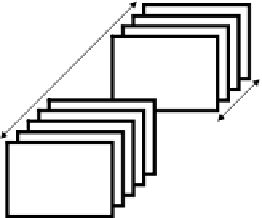Information Technology Reference
In-Depth Information
3.3 MPEG Coding Methods
The features of the major MPEG video coding standards such as MPEG-2,
MPEG-4 visual and AVC/H.264 are introduced [18, 19].
3.3.1 MPEG-2
MPEG-2 is an international standard that specifies video coding for the purpose of
digital television broadcasting with high quality. Various coding tools are included
to support the coding of interlaced video signals. MPEG-2 is used in satellite and
terrestrial digital broadcastings and recording medias such as DVD, and is the
mainstream coding method for video at present. The main features of MPEG-2
video coding are described below.
First, it adopts a hierarchical structure of video format. That is, MPEG-2 video
format has a layered structure composed of Sequence, Group of Picture (GOP),
Picture, Slice and Macroblock (MB) as shown in Fig. 23.
Sequence
GOP
䋨
Group of Picture
䋩
Picture
Macroblock
Slice
16
8
Y0 Y1
8
16
Y2 Y3
Cb
8
Cr
8
Picture
Fig. 23
Hierarchical structure of MPEG-2 video format
Secondly, three kinds of fundamental picture types and various prediction
methods are adopted for Motion Compensated Prediction. Prediction efficiency is
increased by adopting forward, backward, and bi-directional predictions. Forward
prediction is a method of predicting the present frame from the past frame in time.
Backward prediction is a method of coding the future frame and predicting a past
frame from it. Bi-directional prediction is a method of using both the past and the
future frames for prediction. Then, three kinds of pictures such as I, P, and B pic-
tures are defined for using these prediction methods. I pictures are predicted
within itself and do not refer to any other pictures. P pictures are predicted with
only forward prediction. B pictures are predicted by choosing the most effective





